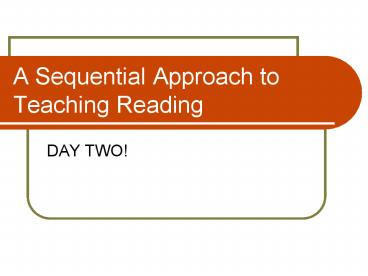A Sequential Approach to Teaching Reading PowerPoint PPT Presentation
1 / 18
Title: A Sequential Approach to Teaching Reading
1
A Sequential Approach to Teaching Reading
- DAY TWO!
2
DAY TWO!
- Day Two Agenda
- Incorporating Centers
- Block 5-Differentiated Text
- Assessment Tools
- Interactive Review
- The Alphabet Series
- Lesson Plans
- Create Your Own Lesson Plan
3
Incorporating Centers
- MacMillan Work Stations
- Red Words/High-Frequency Words
- Swap Card Games
- Dice Game
- Software Programs
- SIO
- Word Maker
- Raz Kids
- Reading A-Z
- Fluency Drills
- Beat the Clock
4
Differentiated Text
- Controlled Text
- Focus Accuracy and automaticity of single word
reading. - Examples Controlled text word lists, phrases
and sentences determined by the word structure
that has been directly taught - Goal of Instruction To develop basic skills for
both reading and spelling. - --2003 Wilson Language Training Corp.
5
Differentiated Text
- Decodable Text
- Focus Fluency
- Examples Passages determined by word structure
directly taught. Consider childs interest and
background schema. - Goal of Instruction To develop fluent and rate
appropriate independent reading of connected text
for meaning. Also, to develop oral reading with
ease and expression. --2003 Wilson Language
Training Corp.
6
Differentiated Text
- Enriched Text
- Focus Vocabulary and comprehension
- Examples Narrative and expository text
determined by highest appropriate instructional
listening comprehension level of student. - Goal of Instruction Passages are read to
students so they can develop comprehension and
vocabulary skills at a higher level than their
decoding ability. - --2003 Wilson Language Training Corp.
7
Leveled Text
- Books are "leveled" (i.e. placed in a certain
category) based on the criteria of the person or
entity leveling the books. Irene C. Fountas and
Gay Su Pinnell, the developers of Guided Reading,
advocate these stages - Emergent Readers (Levels A-E)
- Early Readers (Levels F-J)
- Early Fluent Readers (Levels K-P)
- Fluent Readers (Levels Q-W).
8
Leveled Text
- The Lexile Framework is another leveled text
tool. Lexile measures reader ability and text
difficulty by the same standard as the Fountas
and Pinnell model. - The leveling of texts allows teachers to match
books with an individual student's reading
ability.
9
Differentiated Text Examples
- Students will have numerous chances for
successful practice with - The Alphabet Series
- Wilson student reader stories
- Macmillian fluency and leveled readers
- High Noon Books-Sound Out Chapter Books
- Bruce Larkin Easy Readers
- Phonics through Poetry
- Reading/Writing Complex Rhymes
- Picture books
- Trade books
10
Categorizing Fluency
- Readers fall into six different categories.
(Jerry Johns 2008) - Those categories are listed, behaviors are
defined and suggestions for focus are given in
the handout.
11
Assessment Tools
- Sequential Sound Chart
- Really Great Reading Survey
- Stage 2 Assessment
- Running records
- Dr. Frys informal reading assessments
- Aimsweb
12
Welcome back from lunch!
- Can you solve these trivia questions?
- What is the shortest ology (study of) words?
- What is the only word in which an f is
pronounced like a v?
13
Interactive Review
- Practice the three part sound drill (Block 1)
- Group Graphic Organizer
- Graphic Organizer for teaching a new concept
(Block 3)
14
The Alphabet Series
- 3 copies of each text from 3 levels
- Workbooks 1-8
- Cheat Sheet
- Oral reading
- Silent reading
- Repeated readings
15
Lesson Plan Examples
- Real students
- Lesson Demo
16
Create Your Own Lesson Plan
- Lists of K/1 students who are struggling readers
- Criteria for intervention
- Bottom 15 of spring ISEL scores
- Phonemic awareness
- Letter sounds
- Not in Reading Recovery
17
Create Your Own Lesson Plan
- Choose a student or group of students
- Think a bit about where to start with this
student or group - Refer to your Recipe for Reading book
- Use your binder for reference and the lesson plan
examples - Browse through the series of books and poems for
appropriate text to use.
18
Questions
- Website info for evaluations
- THANK YOU!
- We appreciate your attendance and positive
attitudes in trying this intervention. - Email or call one of us if you need help or have
questions as school begins. - JudyNimmo_at_sd54.org 6895
- CaronGibbert_at_sd54.org 2074

